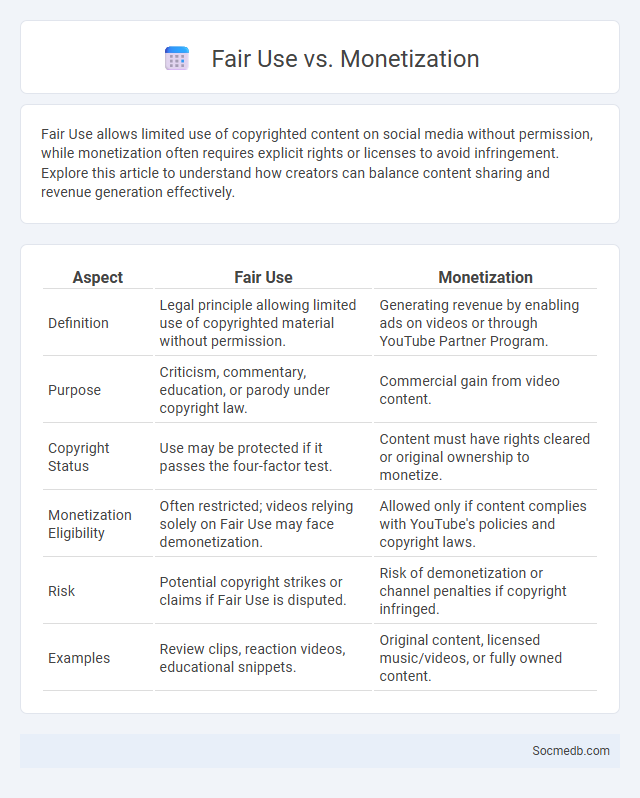
Photo illustration: Fair Use vs Monetization
Fair Use allows limited use of copyrighted content on social media without permission, while monetization often requires explicit rights or licenses to avoid infringement. Explore this article to understand how creators can balance content sharing and revenue generation effectively.
Table of Comparison
| Aspect | Fair Use | Monetization |
|---|---|---|
| Definition | Legal principle allowing limited use of copyrighted material without permission. | Generating revenue by enabling ads on videos or through YouTube Partner Program. |
| Purpose | Criticism, commentary, education, or parody under copyright law. | Commercial gain from video content. |
| Copyright Status | Use may be protected if it passes the four-factor test. | Content must have rights cleared or original ownership to monetize. |
| Monetization Eligibility | Often restricted; videos relying solely on Fair Use may face demonetization. | Allowed only if content complies with YouTube's policies and copyright laws. |
| Risk | Potential copyright strikes or claims if Fair Use is disputed. | Risk of demonetization or channel penalties if copyright infringed. |
| Examples | Review clips, reaction videos, educational snippets. | Original content, licensed music/videos, or fully owned content. |
Understanding Fair Use: Definition and Purpose
Fair use is a legal doctrine allowing limited use of copyrighted material without permission for purposes such as criticism, commentary, news reporting, education, and research. Its purpose is to balance the rights of creators with the public interest, enabling freedom of expression and innovation on social media platforms. Understanding fair use helps content creators avoid copyright infringement while leveraging existing works to enrich online discussions and creativity.
Monetization Explained: Turning Content into Revenue
Social media platforms enable content creators to monetize their audiences through diverse revenue streams such as advertising partnerships, sponsored posts, and affiliate marketing. Tools like YouTube AdSense, Instagram Shopping, and TikTok Creator Fund provide structured opportunities for influencers to generate income based on engagement metrics. Understanding algorithm-driven visibility and audience analytics is crucial for maximizing monetization potential and sustaining long-term revenue growth.
The Legal Framework of Fair Use
The legal framework of fair use protects your ability to share, comment, and remix content on social media without infringing copyright laws. Courts consider factors such as the purpose of use, the nature of the copyrighted work, the amount used, and the effect on the market value when determining fair use eligibility. Understanding these guidelines helps you navigate social media sharing responsibly while respecting intellectual property rights.
Common Misconceptions About Fair Use
Common misconceptions about fair use on social media often include the belief that sharing copyrighted content without permission is always permissible under fair use. Many users incorrectly assume that adding commentary or using content for non-commercial purposes automatically qualifies as fair use. Understanding the four factors of fair use--purpose, nature, amount, and market effect--is essential to correctly assess whether a social media post infringes copyright law.
Monetization and Copyright: What Content Creators Need to Know
Content creators must understand that monetization on social media platforms often requires adherence to strict copyright laws and platform-specific policies to avoid demonetization or account suspension. Utilizing copyrighted materials without proper licenses or permissions can lead to copyright strikes, limiting revenue potential and audience reach. To maximize earnings, creators should focus on producing original content, using royalty-free resources, or securing explicit rights for third-party content.
The Intersection of Fair Use and Monetization
Social media platforms increasingly challenge the boundaries between fair use and monetization, as creators leverage copyrighted content to generate revenue while navigating legal risks. Understanding the nuances of transformative use, commentary, and parody is essential for avoiding copyright infringement claims and ensuring compliant monetization strategies. Policies from platforms like YouTube and Facebook continually evolve to balance copyright protection with creators' rights to earn income from fair use content.
YouTube, Fair Use, and Ad Revenue Policies
YouTube's Fair Use policy allows creators to use copyrighted material under specific conditions such as commentary, criticism, or educational purposes without infringement. The platform's Ad Revenue policies require compliance with content guidelines, demonetizing videos that contain inappropriate or copyrighted material. Understanding these regulations helps creators maximize earnings while respecting intellectual property rights and maintaining channel integrity.
Famous Fair Use Court Cases and Their Impact
Famous fair use court cases such as Campbell v. Acuff-Rose Music and Cariou v. Prince have significantly shaped social media content guidelines by clarifying the boundaries of copyright in digital spaces. These rulings emphasize transformative use and the purpose of use, allowing creators to remix and share content without facing legal repercussions when done responsibly. The precedent set by these cases continues to influence platform policies and user behavior, fostering a balance between protecting original works and encouraging creative expression online.
Best Practices for Monetizing Fair Use Content
Monetizing fair use content on social media requires careful adherence to copyright laws while leveraging user-generated material, reviews, or commentary that adds significant value. You should consistently provide transformative content that avoids infringing on original works, ensuring your content qualifies under fair use guidelines. Clear attribution and maintaining transparency with your audience enhance credibility and help maximize your revenue potential sustainably.
Protecting Your Work: Striking a Balance Between Fair Use and Monetization
Creators face challenges in protecting their intellectual property on social media while leveraging fair use to expand reach and monetize content effectively. Implementing watermarking, copyright notices, and digital rights management tools helps safeguard original work against unauthorized use and potential revenue loss. Striking a balance between fair use and monetization strategies ensures sustainable income streams without compromising content integrity or audience trust.
 socmedb.com
socmedb.com